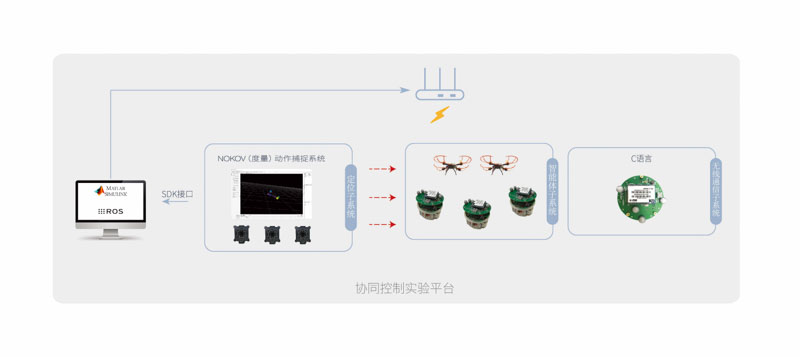In any human endeavor, teamwork is always emphasized. With the interdisciplinary development and integration of control science, computer science, and other disciplines, the control of individual robots, drones, and unmanned vehicles can no longer meet the current technical demands of the field. Just like humans, these intelligent entities need to complete multi-unit, multi-dimensional collaborative work. Thus, the collaborative control and application of multi-agent systems have become one of the hot research topics in the fields of control, mathematics, communication, biology, and artificial intelligence.
In the process of multi-agent collaborative control, the mainstream positioning technologies used are Optical Motion Capture and UWB (Ultra Wide Band). Each technology has its unique characteristics.
Optical motion capture in cooperative control experiments obtains the position and orientation information of intelligent agents through camera-captured marker points on the agents. This data is transmitted to the host computer via SDK or VRPN, and real-time control is completed through the host computer's calculations and actual control software via wireless signals to the intelligent agents. Meanwhile, UWB (Ultra-Wideband) technology is a wireless carrier communication technology that uses a frequency bandwidth of over 1 GHz. It cannot fully serve as a positioning control technology but rather allows intelligent agents to carry signal transmitters, indirectly acquiring their positions through this communication method. Compared to UWB technology, which only provides single-position information, optical motion capture can simultaneously offer both position and posture information of the agents. In today's increasingly diverse and complex market, intelligent agents that only have positional mobility can no longer meet market demands. What's needed now are drones that don't just fly in straight lines but can also know their posture in the air, make adjustments on the fly, and even perform rolls. At this point, UWB technology cannot meet the control requirements.

Regarding data support, there is also the indoor Ultra-Wideband (UWB) system, which significantly reduces overall precision to approximately centimeter level in civilian and commercial settings, and the transmission range is limited to about 10 meters. In contrast, optical motion capture systems can achieve sub-millimeter accuracy indoors, and the capture range can be unlimited depending on the setup of the site and the number of cameras.
Optical motion capture systems not only provide high accuracy and low interference information, but they also transmit the position and posture data of intelligent agents back to the host in real-time. The overall data transmission to the agents is low-latency, with delays possibly as low as a few milliseconds.
From a hardware perspective, UWB (Ultra-Wideband) requires the installation of radio wave transmitting devices on agents, increasing the complexity and unpredictability during collaborative control processes. In contrast, optical motion capture systems only require a few lightweight, specialized marker points to be attached to the agents, without the need for additional equipment. This ensures that accurate positional and attitudinal information can be provided without interfering with the collaborative control process, offering a stable and reliable activity space.
Many teams in China are now conducting research on multi-agent collaborative control. Professor Xia Yuanqing's team at Beijing Institute of Technology has completed research on ground-air collaborative control. After multiple comparisons of different positioning technologies, the team adopted the NOKOV optical 3D motion capture system as their positioning system. The NOKOV system effectively provided spatial location and attitude information for unmanned aerial vehicles and unmanned ground vehicles, enabling the research to proceed smoothly. The research was even reported by Xinhua Net.